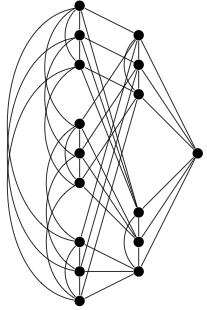Organizers: David
Gunderson, Karen Gunderson, JD Nir, and Andrii Arman
Time: Fridays 2:30pm
Zoom link: https://zoom.us/j/98499266029, password is the first six Fibonacci numbers, starting with 11...
Mailing list: https://lists.umanitoba.ca/mailman/listinfo/comb-sem
Topics including graphs and hypergraphs, algebraic graph theory, finite geometries, random processes, extremal or Ramsey theory, applications of combinatorics, combinatorial geometry, partial orders, design theory, combinatorial matrix theory, additive combinatorics.
Talks can be surveys, works in progress, introductions to an area, or recent results. All are welcome to attend and to volunteer talks. Talks should be aimed at a wide audience of combinatorialists and should be understandable to graduate students.

Subscription to the calendar is available via:
https://www.google.com/calendar/ical/4aq25ijhgs0tb19k9cni79ucps%40group.calendar.google.com/public/basic.ics
Schedules for past seminars are available here.
| Date | Speaker | Title |
|---|---|---|
| 21 Jan 2022 | Ranganathan Padmanabhan | Zero-Sum Geometries |
| 28 Jan 2022 | ||
| 4 Feb 2022 | ||
| 11 Feb 2022 | ||
| 18 Feb 2022 | ||
| 25 Feb 2022 | No seminar - Reading week | |
| 4 Mar 2022 | ||
| 11 Mar 2022 | ||
| 18 Mar 2022 | ||
| 25 Mar 2022 | ||
| 1 Apr 2022 | ||
| 8 Apr 2022 | ||
| 15 Apr 2022 | No seminar - Good Friday | |
| 22 Apr 2022 |

Speaker: Ranganathan Padmanabhan (Manitoba, Math)
Title: Zero-Sum Geometries
Abstract: The classical theory of cubic curves has a harmonizing blend of algebra, geometry, number theory, combinatorics with applications to cryptography and computer science. Here we start from the well-known fact that cubic curves (defined over a field k) admit a group law $\oplus$ over k such that three points $\{P,Q,R\}$ on the curve are collinear if and only if $P \oplus Q \oplus R = 0$ under the group law. This is a typical example of - what may be called - a zero-sum geometry (term borrowed from [5]). An (n,k)-configuration in a projective plane over k consists of a set of n points, and a finite arrangement of k lines (also called blocks), such that each line is incident with k points. A famous problem here is the geometric realization of such abstract configurations, see [1]. The sought-after realization is, of course, over the real plane. But, as discovered by J.J. Sylvester way back in 1895, there are many important and beautiful configurations which cannot be realized over the real plane. In this talk, we show how cubic curves equipped with its geometrically defined group law will be an useful tool in deciding the realizability of several (n,3) and (n,4) configurations. This is part of ongoing research done in collaboration with Jeffrey Lanyon and Dr. Alok Shukla (Ahmedabad University).
References
[1] Grünbaum, Branko, Configurations of Points and Lines, Graduate Studies in Mathematics, 103, AMS, 2009.
[2] Lanyon, Jeffrey, Group Realizations of Configurations, M.Sc. Thesis, University of Manitoba, 2018.
[3] Mendelsohn, N. S. ; Padmanabhan, R. Wolk, B., Placement of the Desargues configuration on a cubic curve. Geom. Dedicata 40 (1991), no. 2, 165-170.
[4] Padmanabhan, R and Shukla, Alok, Orchards in elliptic curves over finite fields, Finite Fields and Their Applications 68 (2020), AMS-MR4158718, 17pp.
[5] Wolfram, Cubic Curves and Zero-Sum Geometries
https://blog.wolfram.com/2018/02/02/cultivating-new-solutions-for-the-orchard-planting-problem/